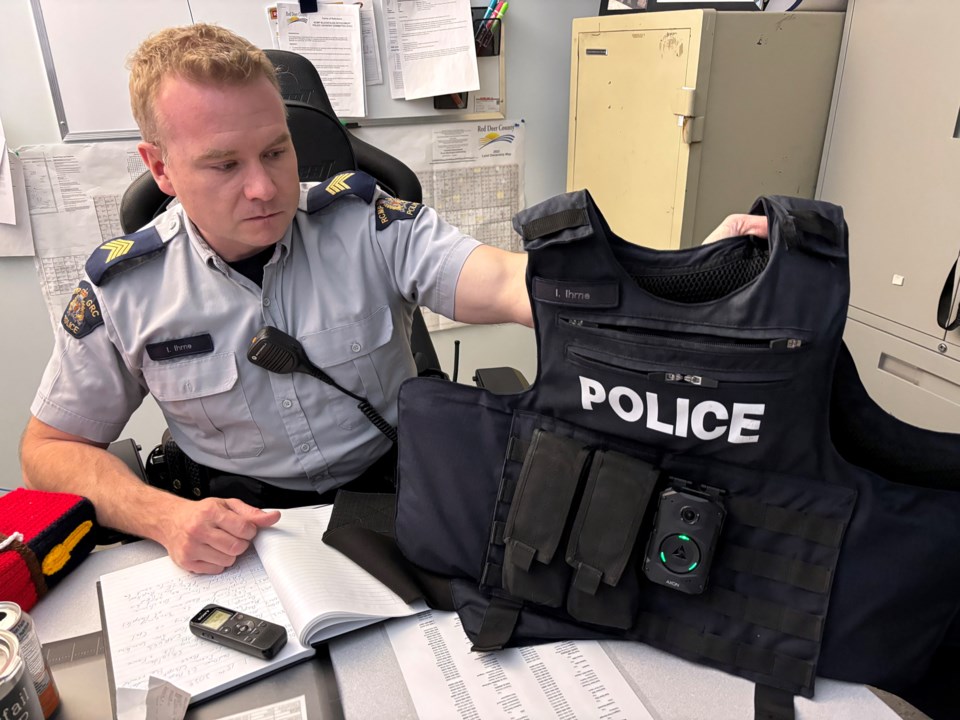INNISFAIL – All 18 members of the Innisfail RCMP detachment are now suited up with high tech body-worn cameras.
The new technology arrived at the detachment for all police officers on April 14, and training began immediately.
“Half of us did it yesterday (April 14), the other half of us are doing it today,” said detachment commander Staff Sgt. Ian Ihme.
He said his officers were shown the camera’s different features, their limitations, how to perform file transfers and redacting.
“If we're dealing with a complaint, dealing with a bad guy, and there's uninvolved innocent people that walk through the camera we have to redact out their faces for privacy reasons,” said Ihme. “A lot of it was learning about that, just the logistics of working on the computer software and how to do that.
“There's a unit in Edmonton that can help us with the redactions.”
Ihme said the cameras are on all the time for each on-duty police officer, but they are not always recording.
“The policy is that anytime we go for a call for service and we're dealing with somebody, that's when we turn them on,” said Ihme, noting the flashing green light for when the camera is powered on and the red light for recording. “When the call for service is done, then we just turn it off and it goes back to green.”
And when the call for service is over, and the police officer returns to the detachment the images and audio are downloaded into a docking station.
Ihme added the process also “auto-generates” a transcript of the encounter.
“It goes to a cloud server, and it will automatically transcribe what we discussed or was on the video,” said Ihme. “If there's a really long encounter you can start reading through the transcript because you're looking for the point where the suspect said whatever.
“You can click on that point of the transcript, and it takes you to that part of the video.”
It was on Nov. 14 of last year when the RCMP announced a national deployment of body-worn cameras.
The goal was to have 90 per cent of frontline members using body-worn cameras with full deployment completed by the next 12 to 18 months.
The cost is about $3,000 for each of Innisfail RCMP’s 18 new cameras, a leased package that includes the camera, training, storage, and downloading.
Policing costs in Innisfail is a three-way split between the federal government, the province and the town.
Ihme has always been “100 per cent” in favour of the new technology.
“There are advantages right off the start, and not just for the police but for everybody. The big reason for it is for trust and accountability,” said Ihme. “We said something happened, right? And sometimes people are like, ‘Did it really happen the way the police are saying it?
“You don't have that argument of, ‘I didn't actually say that,” he added. “So, it's trust and accountability, and then there's the ability for supervisors and the justice system judges to actually watch what happened.”
But Ihme conceded there are limitations with the new body-worn cameras.
“It's on the front of my body and if my hands are out and I'm dealing with somebody it could be obstructed,” said Ihme, adding there are also “certain” limitations with the actual technology.
“There’s a little bit of a bird's eye view. It gives a fairly wide peripheral. It doesn't necessarily see what I'm always seeing.”
However, despite those limitations Ihme believes the new cameras is a big leap forward for the police from an evidentiary standpoint, as the rolling video and audio from the moment a police officer arrives at the scene will capture a fuller context of the incident.
“People often resist arrest. The cameras will show what led up to that and what the person was actually doing to resist,” said Ihme. “It comes down to the public being able to have that trust and transparency of what we're doing.”



